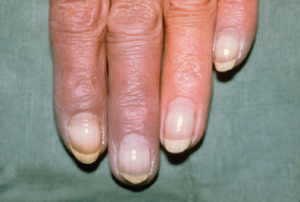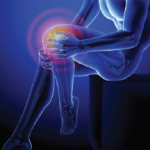
Clinical Photography, Central Manchester University Hospitals NHS Foundation Trust, UK / Science Source
SAN DIEGO—Top researchers gathered for a review course at the start of the 2017 ACR/ARHP Annual Meeting in November to describe new research, their own treatment strategies and new ways of thinking about an array of rheumatic diseases. Here are the highlights:
Raynaud’s & Other Digit Problems
When a patient walks into your clinic with blue fingers or toes, it can be a dramatic situation that requires quick action. Fred Wigley, MD, director of the Johns Hopkins Scleroderma Center in Baltimore, discussed these types of cases at the review course. He offered lessons on how this problem comes about, how to discern the cause and what to do about it.
Under normal conditions, the vessels regulating temperature subtly shift blood flow throughout the body to maintain the right temperature in the body’s core. The skin has an incredible capacity for this blood flow, able to accommodate 60% of the cardiac output. These thermal regulatory vessels are controlled by alpha 2 receptors that pick up norepinephrine from the sympathetic nervous system that can be triggered by skin cooling or a central body chill. Then the shunt contracts and restricts flow to the blood surface.
The vessels that provide nutritional blood flow have independent and distinct roles from the thermal regulatory vessels, or AV shunts. “The reason for that is the endothelial layer on the arterial flow and to the nutritional system maintains vasodilation to counteract the constrictive process,” Dr. Wigley said. This distinction “is important when we talk about danger” to the digits.
Patients presenting with Raynaud’s phenomenon and cold ischemic changes of the nose almost always have a circulating factor (e.g., cryoglobulines, cryofibrinogens) as a cause. “If you have ischemic lesions, you don’t have primary Raynaud’s,” Dr. Wigley said. Primary Raynaud’s is a symmetrical process involving all the fingers and the toes, with no ischemic lesions, sparing of the thumb, normal nailfold capillaries on exam and usually a negative serology.
Acrocyanosis can mimic Raynaud’s. It’s a nonparoxysmal, persistent, painless, symmetrical cyanosis of the hands (and sometimes the feet and knees) caused by vasospasm of the small vessels of the skin. Causes of secondary Raynaud’s include scleroderma, systemic lupus erythematosus (SLE), carpal tunnel syndrome, vibration, frostbite and certain drugs, including Ritalin.
One way to tell whether a patient with “very scary blue fingers” simply has cold fingers or has critical ischemia is to push on them. If you see rapid reflow, “that’s reassuring that there’s no critical ischemia,” Dr. Wigley said. If the reflow is slow, “you’ve got to be worried they’re going to have a catastrophic event” associated with irreversible, compromised blood flow.


